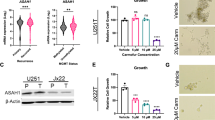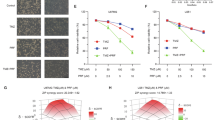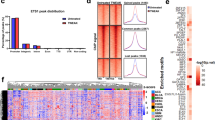Abshead
The present study was designed to examine the roles of p53, reactive oxygen species (ROS), and ceramide, and to determine their mutual relationships during tumor necrosis factor (TNF)-α-induced apoptosis of human glioma cells. In cells possessing wild-type p53, TNF-α stimulated ceramide formation via the activation of both neutral and acid sphingomyelinases (SMases), accompanied by superoxide anion (O2−•) production, and induced mitochondrial depolarization and cytochrome c release, whereas p53-deficient cells were partially resistant to TNF-α and lacked O2−• generation and neutral SMase activation. Restoration of functional p53 sensitized glioma cells expressing mutant p53 to TNF-α by accumulation of O2−•. z-IETD-fmk (benzyloxycarbonyl-Ile-Glu-Thr-Asp fluoromethyl ketone), but not z-DEVD-fmk (benzyloxycarbonyl-Asp-Glu-Val-Asp fluoromethyl ketone), blocked TNF-α-induced ceramide formation through both SMases as well as O2−• generation. Caspase-8 was processed by TNF-α regardless of p53 status of cells or the presence of antioxidants. Two separate signaling cascades, p53-mediated ROS-dependent and -independent pathways, both of which are initiated by caspase-8 activation, thus contribute to ceramide formation in TNF-α-induced apoptosis of human glioma cells.
Similar content being viewed by others
Log in or create a free account to read this content
Gain free access to this article, as well as selected content from this journal and more on nature.com
or
Abbreviations
- ROS:
-
reactive oxygen species
- O2−•:
-
superoxide anion
- H2O2:
-
hydrogen peroxide
- •OH:
-
hydroxyl radical
- TNF:
-
tumor necrosis factor
- SM:
-
sphingomyelin
- SMase:
-
sphingomyelinase
- N-SMase:
-
neutral sphingomyelinase
- A-SMase:
-
acid sphingomyelinase
- HPV:
-
human papillomavirus
- CHX:
-
cycloheximide
- SR33557:
-
((2-isopropyl-1-(4- [3-N-methyl-N- (3,4-dimethoxy-beta-phenethyl) amino] propyloxy)-benzenesulfonyl))indolizine
- FB1:
-
fumonisin B1
- SOD:
-
superoxide dismutase
- HE:
-
hydroethidium
- DCFH-DA:
-
2′,7′-dichlorofluorescein diacetate
- DCF:
-
2′,7′-dichlorofluorescein
- GSH:
-
reduced glutathione
- MTp53ts:
-
temperature-sensitive human p53 val138 mutant
- Δψm:
-
mitochondrial transmembrane potential
- DiOC6(3):
-
3,3′-dihexyloxacarbocyanine iodide
- z-IETD-fmk:
-
benzyloxycarbonyl-Ile-Glu-Thr-Asp fluoromethyl ketone
- z-DEVD-fmk:
-
benzyloxycarbonyl-Asp-Glu-Val-Asp fluoromethyl ketone
- CA074 Me:
-
[L-3-trans-(propylcarbamoyl)oxirane-2-carbonyl]-L-isoleucyl-L-proline methyl ester
- NAC:
-
N-acetylcysteine
- shRNA:
-
short hairpin RNA
- DMEM:
-
Dulbecco's modified Eagle's medium
- FBS:
-
fetal bovine serum
- HPTLC:
-
high-performance thin-layer chromatography
- SDS-PAGE:
-
sodium dodecylsulfate polyacrylamide gel electrophoresis
References
Hennet T, Richter C and Peterhans E (1993) Tumor necrosis factor-α induces superoxide anion generation in mitochondria of L929 cells. Biochem. J. 289: 587–592
Phelps DT, Ferro TJ, Higgins PJ, Shankar R, Parker DM and Johnson A (1995) TNF-α induces peroxynitrite-mediated depletion of lung endothelial glutathione via protein kinase C. Am. J. Physiol. 269: L551–L559
Garcia-Ruiz C, Colell A, Mari M, Morales A and Fesrandez-Checa JC (1997) Direct effects of ceramide on the mitochondrial electron transport chain leads to generation of reactive oxygen species. J. Biol. Chem. 272: 11369–11377
Heller RA and Kronke M (1994) Tumor necrosis factor receptor-mediated signaling pathways. J. Cell Biol. 126: 5–9
Suzuki YJ, Forman HJ and Sevanian A (1997) Oxidants as stimulators of signal transduction. Free Radic. Biol. Med. 22: 269–285
Gotlieb WH, Watson JM, Rezai A, Johnson M, Martinez-Maza O and Berek JS (1994) Cytokine-induced modulation of tumor suppressor gene expression in ovarian cancer cells: up-regulation of p53 gene expression and induction of apoptosis by tumor necrosis factor-α. Am. J. Obstet. Gynecol. 170: 1121–1130
Yin D, Kondo S, Barnett GH, Morimura T and Takeuchi J (1995) Tumor necrosis factor-α induces p53-dependent apoptosis in rat glioma cells. Neurosurgery 37: 758–763
Cai Z, Capoulade C, Moyret-Lalle C, Amor-Gueret M, Feunteun J, Larsen AK, Bressec-de Paillerets B and Chouaib S (1997) Resistance of MCF7 human breast carcinoma cells to TNF-induced cell death is associated with loss of p53 function. Oncogene 15: 2817–2826
Donato NJ and Perez M (1998) Tumor necrosis factor-induced apoptosis stimulates p53 accumulation and p21WAF1 proteolysis in ME-180 cells. J. Biol. Chem. 273: 5067–5072
Rokhlin OW, Gudkov AV, Kwek S, Glover RA, Gewies AS and Cohen MB (2000) p53 is involved in tumor necrosis factor-α-induced apoptosis in the human prostatic carcinoma cell line LNCaP. Oncogene 19: 1959–1968
Johnson TM, Yu ZX, Ferrans VJ, Lowenstein RA and Finkel T (1996) Reactive oxygen species are downstream of p53-dependent apoptosis. Proc. Natl. Acad. Sci. USA 93: 11848–11852
Polyak K, Xia Y, Zweier JL, Kinzler KW and Vogelstein B (1997) A model for p53-induced apoptosis. Nature 389: 300–305
Li PF, Dietz R and von Harsdorf R (1999) p53 regulates mitochondrial membrane potential through reactive oxygen species and induces cytochrome c-independent apoptosis blocked by Bcl-2. EMBO J. 18: 6027–6036
Krown KA, Page MT, Nguyen C, Zechner D, Gutierrez V, Comstock KL, Glembotski CC, Quintana PJ and Sabbadini RA (1996) Tumor necrosis factor α-induced apoptosis in cardiac cell death. J. Clin. Invest. 98: 2854–2865
Perry DK and Hannun YA (1998) The role of ceramide in cell signaling. Biochem. Biophys. Acta 1436: 233–243
Kolesnick RN, Goni FM and Alonso A (2000) Compartmentalization of ceramide signaling: physical foundations and biological effects. J. Cell. Physiol. 184: 285–300
Wiegmann K, Schutze S, Machleidt T, Witte D and Kronke M (1994) Functional dichotomy of neutral and acidic sphingomyelinases in tumor necrosis factor signaling. Cell 78: 1005–1015
Singh I, Pahan K, Khan M and Singh AK (1998) Cytokine-mediated induction of ceramide production is redox-sensitive. J. Biol. Chem. 273: 20354–20362
Scheffner M, Huibregtse JM, Vierstra RD and Howley PM (1993) The HPV-16 E6 and E6-AP complex functions as a ubiquitin–protein ligase in the ubiquitination of p53. Cell 75: 495–505
Kiyono T, Hiraiwa A, Fujita M, Hayashi Y, Akiyama T and Ishibashi M (1997) Binding of high-risk human papillomavirus E6 oncoproteins to the human homologue of the Drosophila discs large tumor suppressor protein. Proc. Natl. Acad. Sci. USA 94: 11612–11616
Kiyono T, Foster SA, Koop JI, McDougall JK, Galloway DA and Klingelhutz AJ (1998) Both Rb/p16INK4a inactivation and telomerase activity are required to immortalize human epithelial cells. Nature 396: 84–88
Sawada M, Nakashima S, Kiyono T, Nakagawa M, Yamada J, Yamakawa H, Banno Y, Shinoda J, Nishimura Y, Nozawa Y and Sakai N (2001) p53 regulates ceramide formation by neutral sphingomyelinase through reactive oxygen species in human glioma cells. Oncogene 20: 1368–1378
Klingelhutz AJ, Foster SA and McDougall JK (1996) Telomerase activation by the E6 gene product of human papillomavirus type 16. Nature 380: 79–82
Gomez-Manzano C, Fueyo J, Kyritsis AP, Steck PA, Roth JA, McDonnell TJ, Steck KD, Levin VA and Yung WK (1996) Adenovirus-mediated transfer of the p53 gene produces rapid and generalized death of human glioma cells via apoptosis. Cancer Res. 56: 694–699
Brann AB, Scott R, Neuberger Y, Abulafia D, Boldin S, Fainzilber M and Futerman AH (1999) Ceramide signaling downstream of the p75 neurotrophin receptor mediates the effects of nerve growth factor on outgrowth of cultured hippocampal neurons. J. Neurosci. 19: 8199–8206
Chen J-K, Capdevila J and Harris RC (2001) Cytochrome P450 epoxygenase metabolism of arachidonic acid inhibits apoptosis. Mol. Cell. Biol. 21: 6322–6331
Jaffrezou JP, Levada T, Chatelain P and Laurent G (1992) Modulation of subcellular distribution of doxorubicin in multidrug resistant P388/ADR mouse leukemia cells by the chemosensitizer ((2-isopropyl-1-(4- [3-N-methyl-N-(3,4-dimethoxy-beta-phenethyl)amino] propyloxy)-benzenesulfonyl))indolizine. Cancer Res. 52: 6440–6446
Higuchi M, Singh S, Jaffrezou JP and Aggarwal BB (1996) Acidic sphingomyelinase-generated ceramide is needed but not sufficient for TNF-induced apoptosis and nuclear factor-κB activation. J. Immunol. 156: 297–304
Harel R and Futerman AH (1993) Inhibition of sphingolipid synthesis affects axonal outgrowth in cultured hippocampal neurons. J. Biol. Chem. 268: 14476–14481
Posse de Chaves EI, Bussiere M, Vance DE, Campenot RB and Vance JE (1997) Elevation of ceramide within distal neurites inhibits neurite growth in cultured rat sympathetic neurons. J. Biol. Chem. 272: 3028–3035
Xie YW, Kaminski PM and Wolin MS (1998) Inhibition of rat cardiac muscle contraction and mitochondrial respiration by endogenous peroxynitrite formation during posthypoxic reoxygenation. Circ. Res. 82: 891–897
Moreno-Manzano V, Ishikawa Y, Lucio-Cazana J and Kitamura M (2000) Selective involvement of superoxide anion, but not downstream compounds hydrogen peroxide and peroxynitrite, in tumor necrosis factor-α-induced apoptosis of rat mesangial cells. J. Biol. Chem. 275: 12684–12691
Michalovitz D, Halevy O and Oren M (1990) Conditional inhibition of transformation and of cell proliferation by a temperature-sensitive mutant of p53. Cell 62: 671–680
Vayssiere JL, Petit PX, Risler Y and Mignotte B (1994) Commitment to apoptosis is associated with changes in mitochondrial biogenesis and activity in cell lines conditionally immortalized with simian virus 40. Proc. Natl. Acad. Sci. USA 91: 11752–11756
Petit PX, Lecoeur H, Zorn E, Dauguet C, Mignotte B and Gougeon ML (1995) Alterations in mitochondrial structure and function are early events of dexamethasone-induced thymocyte apoptosis. J. Cell Biol. 130: 157–167
Zamzami N, Marchetti P, Castedo M, Zanin C, Vayssiere JL, Petit PX and Kroemer G (1995) Reduction in mitochondrial potential constitutes an early irreversible step of programmed lymphocyte death in vivo. J. Exp. Med. 181: 1661–1672
Beidler DR, Tewari M, Friesen PD, Poirier G and Dixit VM (1995) The baculovirus p35 protein inhibits Fas- and tumor necrosis factor-induced apoptosis. J. Biol. Chem. 270: 16526–16528
Miura M, Friedlander RM and Yuan J (1995) Tumor necrosis factor-induced apoptosis is mediated by a CrmA-sensitive cell death pathway. Proc. Natl. Acad. Sci. USA 92: 8318–8322
Guicciardi ME, Deussing J, Miyoshi H, Bronk SF, Svingen PA, Peter C, Kaufmann SH and Gores GJ (2000) Cathepsin B contributes to TNF-α-mediated hepatocyte apoptosis by promoting mitochondrial release of cytochrome c. J. Clin. Invest. 106: 1127–1137
Foghshaard L, Wissing D, Mauch D, Lademann U, Bastholm L, Boes M, Elling F, Leist M and Jaattela M (2001) Cathepsin B acts as a dominant execution protease in tumor cell apoptosis induced by tumor necrosis factor. J. Cell Biol. 153: 999–1010
Buttle DJ, Murata M, Knight CG and Barrett AJ (1992) CA074 methylester: a proinhibitor for intracellular cathepsin B. Arch. Biochem. Biophys. 299: 377–380
Ishidoh K, Takeda-Ezaki M, Watanabe S, Sato N, Akhara M, Imagwa K, Kikuchi M and Kominami E (1999) Analysis of where and which types of proteinases participate in lysosomal proteinase processing using Bafilomycin A1 and Helicobacter pylori Vac A toxin. J. Biochem. 125: 770–779
Nakayama M, Ishidoh K, Kayagaki N, Kojima Y, Yamaguchi N, Nakao H, Kominami E, Okumura K and Yagita H (2002) Multiple pathways of TWEAK-induced cell death. J. Immunol. 168: 734–743
Dbaido GS, Pushkareva MY, Rachid RA, Alter N, Smyth MJ, Obeid LM and Hannun YA (1998) p53-dependent ceramide response to genotoxic stress. J. Clin. Invest. 102: 329–339
Shatrov VA, Ameyar M, Bouquet C, Cai Z, Stancou R, Haddada H and Chouaib S (2000) Adenovirus-mediated wild-type-p53-gene expression sensitizes the – resistant tumor cells to the – induced cytotoxity by altering the cellular redox state. Int. J. Cancer 85: 93–97
Liu B, Andrieu-Abadie N, Levade T, Zhang P, Obeid L and Hannun YA (1998) Glutathione regulation of neutral sphingomyelinase in tumor necrosis factor-α-induced cell death. J. Biol. Chem. 273: 11313–11320
Yoshimura S, Banno Y, Nakashima S, Hayashi K, Yamakawa H, Sawada M, Sakai N and Nozawa Y (1999) Inhibition of neutral sphingomyelinase activation and ceramide formation by glutathione in hypoxic PC 12 cell death. J. Neurochem. 73: 675–683
Okamoto Y, Obeid LM and Hannun YA (2002) Bcl-xL interrupts oxidative activation of neutral sphingomyelinase. FEBS Lett. 530: 104–108
Gudz TI, Tserng KY and Hoppel CL (1997) Direct inhibition of mitochondrial respiratory chain complex III by cell-permeable ceramide. J. Biol. Chem. 272: 24154–24158
Arora AS, Jones BJ, Patel TC, Bronk SF and Gores GJ (1997) Ceramide induces hepatocyte cell death through disruption of mitochondrial function in the rat. Hepatology 25: 958–963
Ghafourifar P, Klein SD, Olivier S, Schenk U, Pruschy M, Rocha S and Richter C (1999) Ceramide induces cytochrome c release from isolated mitochondria. J. Biol. Chem. 274: 6080–6084
Hampton MB and Orrenius S (1997) Dual regulation of caspase activity by hydrogen peroxide: implications for apoptosis. FEBS Lett. 414: 552–556
Vercammen D, Beyaert R, Denecker G, Goossens V, Van Loo G, Declercq W, Grooten J, Fiers W and Vandenabeele P (1998) Inhibition of caspases increases the sensitivity of L929 cells to necrosis mediated by tumor necrosis factor. J. Exp. Med. 187: 1477–1485
Kruman I, Guo Q and Mattson MP (1998) Calcium and reactive oxygen species mediate staurosporine-induced mitochondrial dysfunction and apoptosis in PC12 cells. J. Neurosci. Res. 51: 293–308
Tan S, Sagara Y, Liu Y, Maher P and Schubert D (1998) The regulation of reactive oxygen species production during programmed cell death. J. Cell Biol. 141: 1423–1432
Sawada M, Nakashima S, Banno Y, Yamakawa H, Hayashi K, Takenaka K, Nishimura Y, Sakai N and Nozawa Y (2000) Ordering of ceramide formation, caspase activation, and Bax/Bcl-2 expression during etoposide-induced apoptosis in C6 glioma cells. Cell Death Differ. 7: 761–772
Sawada M, Nakashima S, Banno Y, Yamakawa H, Takenaka K, Shinoda J, Nishimura Y, Sakai N and Nozawa Y (2000) Influence of Bax or Bcl-2 overexpression on the ceramide-dependent apoptotic pathway in glioma cells. Oncogene 19: 3508–3520
Takeda Y, Mori T, Imabayashi H, Kiyono T, Gojo S, Miyoshi S, Ita M, Segawa K, Ogawa S, Sakamoto M, Nakamura S and Umezawa A . Can the life-span of human marrow stromal cells be prolonged by bmi-1 E6, E7, and/or telomerase without affecting cardiomyogenic differentiation? J. Gene. Med., (in press)
Brummelkamp TR, Bernards R and Agami R (2002) A system for stable expression of short interfering RNAs in mammalian cells. Science 296: 550–553
Yoshimura S, Banno Y, Nakashima S, Takenaka K, Sakai H, Nishimura Y, Sakai N, Shimizu S, Eguchi Y, Tsujimoto Y and Nozawa Y (1998) Ceramide formation leads to caspase-3 activation during hypoxic PC12 cell death. J. Biol. Chem. 273: 6921–6927
Acknowledgements
We are grateful to Dr. T Takahashi (Aichi Cancer Center, Japan) for wild-type human p53 plasmid, to Dr. Y Takeuchi (Chester Beatty Laboratories, ICR, UK) for FLYA13 cells, to Dr. J-P Jaffrezou (Claudius Regaud Center, France) for SR33557, and to Dr. T Ogita (Sankyo Co. Ltd, Tokyo, Japan) for scyphostatin. This work was supported in part by the Research Fellowships of the Japan Society for the Promotion of Science for M Sawada (JSPS Research Fellowships for M Sawada). This work was also supported by Grants-in-Aid for Scientific Research (B) (14370429) and Cancer Research (14026065) from The Ministry of Education, Culture, Sports, Science and Technology of Japan.
Author information
Authors and Affiliations
Corresponding author
Additional information
Edited by ME Peter
Rights and permissions
About this article
Cite this article
Sawada, M., Kiyono, T., Nakashima, S. et al. Molecular mechanisms of TNF-α-induced ceramide formation in human glioma cells:P53-mediated oxidant stress-dependent and -independent pathways. Cell Death Differ 11, 997–1008 (2004). https://doi.org/10.1038/sj.cdd.4401438
Received:
Revised:
Accepted:
Published:
Issue date:
DOI: https://doi.org/10.1038/sj.cdd.4401438
Keywords
This article is cited by
-
Lead Nitrate Induces Inflammation and Apoptosis in Rat Lungs Through the Activation of NF-κB and AhR Signaling Pathways
Environmental Science and Pollution Research (2022)
-
Ceramide-orchestrated signalling in cancer cells
Nature Reviews Cancer (2013)
-
Multi-targeted DATS prevents tumor progression and promotes apoptosis in ectopic glioblastoma xenografts in SCID mice via HDAC inhibition
Journal of Neuro-Oncology (2013)
-
Defining a role for sphingosine kinase 1 in p53-dependent tumors
Oncogene (2012)
-
The Roles of Neutral Sphingomyelinases in Neurological Pathologies
Neurochemical Research (2012)



